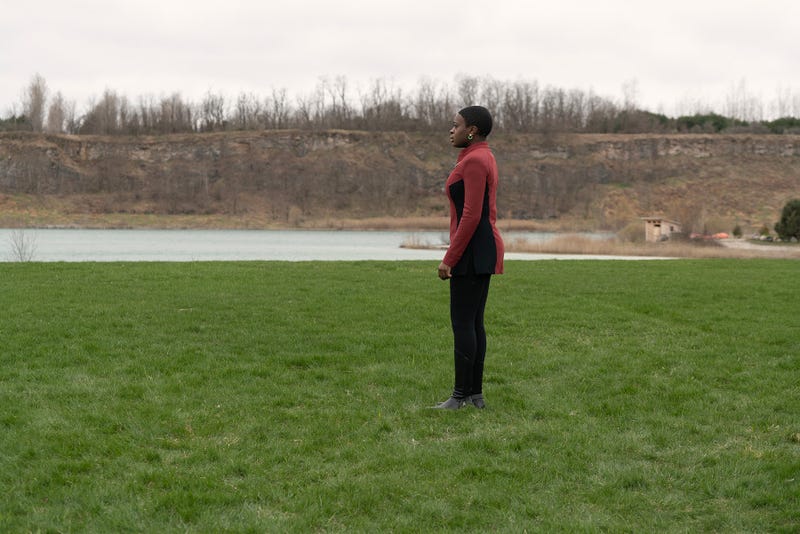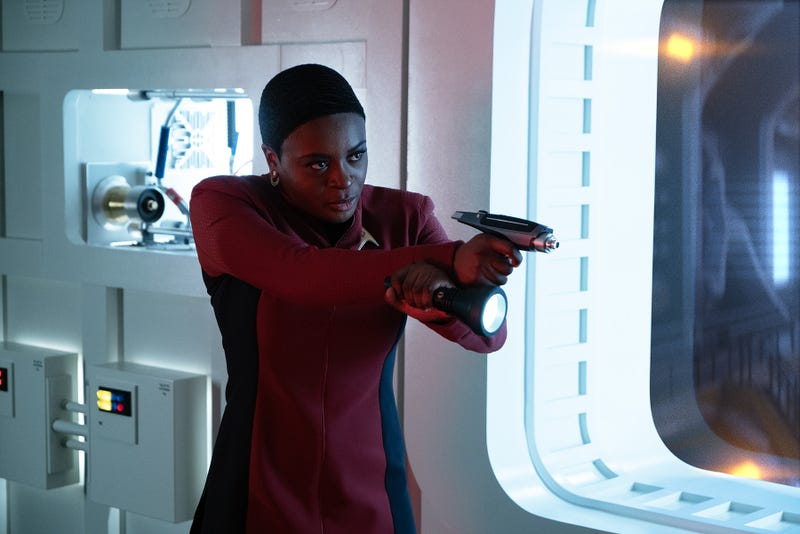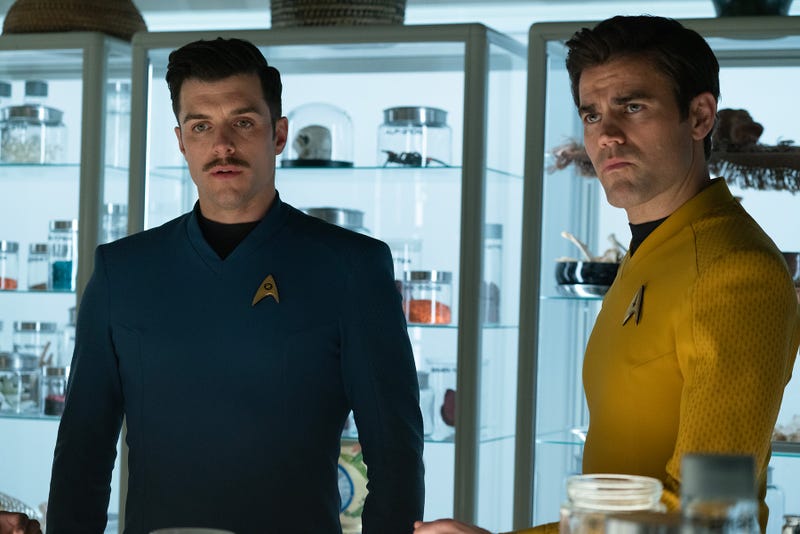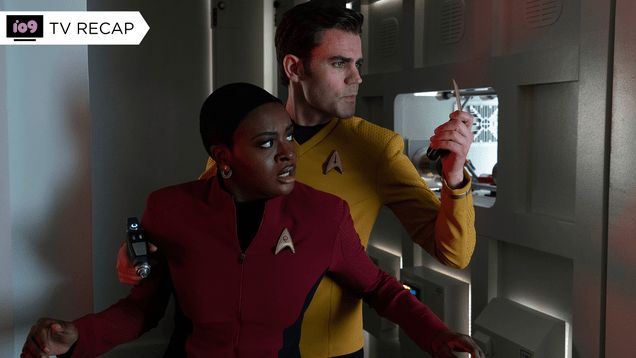Star Trek: Strange New Worlds is far from a show with growing pains—as we’ve said many times already, its first season landed with a confidence of what it wanted to do in ways few Star Trek debuts ever have before it. But it is a show where growing is inevitable: it’s a prequel about Kirk’s Enterprise before Kirk’s on it, so we are constantly anticipating the steps towards that future. But that’s not going to stop Strange New Worlds from examining what that growth means for everyone involved.

On the surface “Lost In Translation,” the sixth episode of the season, brings to Strange New Worlds’ sophomore two elements from its debut that have been so far missing: a focus on Celia Rose Gooding’s now-Ensign Uhura, who has not been given the spotlight like this since the series’ second-ever episode, and a twinge of horror taking a leaf out of the playbook the show has already effectively used in its encounters with the Gorn. As the Enterprise, leading a taskforce that includes the U.S.S. Farragut, heads to a deuterium mining station built by Starfleet on the edge of Federation space—ostensibly a truck stop on exploration into the farthest frontiers, more actually a stronghold on the edge of Gorn space should tensions continue to flare up—Uhura, overstressed and overworked in her eager capacity as the youngest member of the ship’s bridge crew finds herself ruminating on the past, and most pointedly, the loss of guiding figures in her life that have lead her to this moment.

After taking it on herself to fiddle with the Enterprise’s comms relays when she hears a funny sound at her bridge station—leveraging a video she has of the dearly-departed Hemmer (a nice, surprise return for Bruce Horak’s fallen Aenar) guiding her through the process as a cadet, Nyota suddenly finds herself on the way back to the bridge assaulted by a terrifying vision of a zombified Hemmer. But as Uhura’s condition worses and the situation in the nebula gets worse and worse—Number One’s away team to the station, including Hemmer’s replacement as Chief Engineer, Pelia, discover a similarly tormented officer plagued with visions has sabotaged the facility in his mania—the episode leans into, but not as heavily, the spooky horror tropes that defined season 1’s Gorn episodes, fitting given that’s how Uhura lost Hemmer as a friend and mentor in the first place.
Even though there is something of an inevitability in the outcome—fret as Uhura rightfully does that she might suffer the same fate as the stricken mining officer, who ultimately ends up getting blown out into space during a manic episode after his condition deteriorated—there’s still a lot of great tension to be mined out of “Lost In Translation,” full of short, sharp, unsettling shocks, and getting a great deal of making its visions to Uhura and the mining officer blur the lines of surreality. But the spookiness is not the heart of the episode—the message is about acknowledging Uhura’s own growth and need to move on from a lot of the trauma’s she’s faced in her young life, not just with Hemmer’s death, but the shuttle accident that took her family’s life—the reason she was inadvertently put on a path to a career in Starfleet anyway.

And while Gooding is absolutely the star of the episode—giving us a raw vulnerability to Uhura matched by the seeds of the self-assured woman she will become, there’s a fascinating balance at play that they absolutely nail—it is this need to acknowledge growth and change across a bunch of our characters that is the real meat of the episode. We see it touched upon in Spock and Chapel’s burgeoning relationship, as they both try to navigate who they want to be to each other, and who they want to become as they explore this connection. We playfully see it between Pelia and Una, as the latter displays a frustration with the former’s laissez-faire attitude to command protocols that she ultimately reveals stems from a class she took with the long-lived Lanthanite as her tutor at the academy, and even more so briefly in Pike as he jokingly but sincerely tackles the brief, but increased demands of being a Fleet Captain, knowing full well the path he will one day go down.
But perhaps most fascinatingly at play here in Uhura’s own journey of acceptance and acknowledgement is another character at play—the return of Paul Wesley’s Lieutenant James T. Kirk, now the first officer of the Farragut. I’ve said in the past with Wesley’s appearances as the legendary Trek hero that Strange New Worlds should be credited for smartly deploying Kirk in a limited, distanced capacity given the shadow he looms widely over the show. The Kirks we’ve had so far haven’t really been Kirk—alternate timelines, altered realities, the half-Kirks that let the show play with the legend but let him not quite be so looming, and let him in turn be his own character beyond what we know him to one day become. So it’s with some trepidation that Kirk—the Jim Kirk, the definitive article, albeit fresh-faced and early into his command career—enters the halls of the Enterprise here for real. But Strange New Worlds is a smarter show than it often lets on in its nostalgic, borderline-fawning appreciation of Trek’s classic format, and “Lost In Translation” is no exception.

Kirk coming aboard the Enterprise doesn’t feel like a necessary nostalgia play, a contrivance for the audience rather than our characters. He also importantly does not overwhelm the story he finds himself thrust into, even if he becomes a crucial catalyst for Uhura—a nice nod to their future relationship. To the people aboard the Enterprise, save for Pike and La’an (having seen their “own” aforementioned alt-Kirk) Jim is just… well, he’s just a little guy. No one treats this lieutenant any different to how they’d treat another lieutenant, save for a knowing meeting between himself and Mr. Spock near the episode’s end. The shadow Kirk represent never gets the chance to loom, and most crucially it’s because he too taps into these themes of growing up and moving on from past regrets.
We see this in him not just in the ways he helps Uhura navigate and ultimately uncover just what the mysterious visions plaguing her are about—there’s microscopic organisms in the deuterium nebula being essentially tortured by the Federation’s mining operations—but crucially we see it in his relationship with his brother Sam, a heady, testy mix of sibling rivalry and regret that humanizes the both of them really well, in spite of its briefness in this particular narrative. Indeed, when Sam and Jim put their hang-ups with each other aside over their respective career paths in Starfleet by the episode’s end, that aforementioned brief meeting of Spock and Kirk feels less like cutesy nudge and more earned: these are all characters that are still growing as people, no matter their future destinies off and on the Enterprise.

They still have to learn to move on from pain and loss, to walk forward into their futures and meet the people they will one day become—but they’re all still getting there. And even in a story about miscommunication, Strange New Worlds makes it crystal clear that that journey is worth exploring on its own terms.
Want more io9 news? Check out when to expect the latest Marvel, Star Wars, and Star Trek releases, what’s next for the DC Universe on film and TV, and everything you need to know about the future of Doctor Who.
